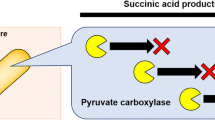Abstract
Using two-dimensional gel electrophoresis (2-DE) and mass spectrometry, the proteome of a metabolically engineered succinic acid-overproducing bacterium, Mannheimia succiniciproducens LPK7, was examined and compared with that of its wild type strain, MBEL55E, to elucidate the physiological and metabolic changes responsible for succinic acid overproduction and cell growth. Comparative proteomic studies clearly showed that the expression levels of enzymes involved in the ATP formation and consumption (AtpD, Ppa, SerS, ProS, Pnp, PotD, MalK, RbsB, and TbpA), pyruvate metabolism (AceF and Lpd), glycolysis (GapA, Pgk, Fba, and TpiA), and amino acid biosynthesis (Asd, DapA, DapD, Gdh, ArgD, and ArgG) varied significantly in the LPK7 strain compared with those in the MBEL55E strain. Based on the comparative proteome profiling, the formation of pyruvic acid, a newly formed byproduct in the engineered LPK7 strain, could be reduced by adding into the culture medium pantothenate and l-cysteine, which serve as precursors of CoA biosynthesis.



Similar content being viewed by others
References
Kabir MM, Shimizu K (2001) Proteome analysis of a temperature-inducible recombinant Escherichia coli for poly-beta-hydroxybutyrate production. J Biosci Bioeng 92:277–284
Aldor IS, Krawitz DC, Forrest W, Chen C, Nishihara JC, Joly JC, Champion KM (2005) Proteomic profiling of recombinant Escherichia coli in high-cell-density fermentations for improved production of an antibody fragment biopharmaceutical. Appl Environ Microbiol 71:1717–1728
Champion KM, Nishihara JC, Aldor IS, Moreno GT, Andersen D, Stults KL, Vanderlaan M (2003) Comparison of the Escherichia coli proteomes for recombinant human growth hormone producing and nonproducing fermentations. Proteomics 3:1365–1373
Han MJ, Jeong KJ, Yoo JS, Lee SY (2003) Engineering Escherichia coli for increased productivity of serine-rich proteins based on proteome profiling. Appl Environ Microbiol 69:5772–5781
Han MJ, Lee SY (2006) The Escherichia coli proteome: past, present, and future prospects. Microbiol Mol Biol Rev 70:362–439
Han MJ, Park SJ, Park TJ, Lee SY (2004) Roles and applications of small heat shock proteins in the production of recombinant proteins in Escherichia coli. Biotechnol Bioeng 88:426–436
Jurgen B, Lin HY, Riemschneider S, Scharf C, Neubauer P, Schmid R, Hecker M, Schweder T (2000) Monitoring of genes that respond to overproduction of an insoluble recombinant protein in Escherichia coli glucose-limited fed-batch fermentations. Biotechnol Bioeng 70:217–224
Rinas U, Hoffmann F (2004) Selective leakage of host-cell proteins during high-cell-density cultivation of recombinant and non-recombinant Escherichia coli. Biotechnol Prog 20:679–687
Wang Y, Wu SL, Hancock WS, Trala R, Kessler M, Taylor AH, Patel PS, Aon JC (2005) Proteomic profiling of Escherichia coli proteins under high cell density fed-batch cultivation with overexpression of phosphogluconolactonase. Biotechnol Prog 21:1401–1411
Pferdeort VA, Wood TK, Reardon KF (2003) Proteomic changes in Escherichia coli TG1 after metabolic engineering for enhanced trichloroethene biodegradation. Proteomics 3:1066–1069
Lee JH, Lee DE, Lee BU, Kim HS (2003) Global analyses of transcriptomes and proteomes of a parent strain and an L-threonine-overproducing mutant strain. J Bacteriol 185:5442–5451
Han MJ, Yoon SS, Lee SY (2001) Proteome analysis of metabolically engineered Escherichia coli producing Poly(3-hydroxybutyrate). J Bacteriol 183:301–308
Lee JW, Lee SY, Song H, Yoo JS (2006) The proteome of Mannheimia succiniciproducens, a capnophilic rumen bacterium. Proteomics 6:3550–3566
Hong SH, Kim JS, Lee SY, In YH, Choi SS, Rih JK, Kim CH, Jeong H, Hur CG, Kim JJ (2004) The genome sequence of the capnophilic rumen bacterium Mannheimia succiniciproducens. Nat Biotechnol 22:1275–1281
Song H, Lee SY (2006) Production of succinic acid by bacterial fermentation. Enzyme Microbial Technol 39:352–361
Kim TY, Kim HU, Park JM, Song H, Kim JS, Lee SY (2007) Genome-scale analysis of Mannheimia succiniciproducens metabolism. Biotechnol Bioeng 97:657–671
Lee SJ, Song H, Lee SY (2006) Genome-based metabolic engineering of Mannheimia succiniciproducens for succinic acid production. Appl Environ Microbiol 72:1939–1948
Bradford MM (1976) A rapid and sensitive method for the quantitation of microgram quantities of protein utilizing the principle of protein-dye binding. Anal Biochem 72:248–254
Han MJ, Lee JW, Lee SY (2005) Enhanced proteome profiling by inhibiting proteolysis with small heat shock proteins. J Proteome Res 4:2429–2434
Laemmli UK (1970) Cleavage of structural proteins during the assembly of the head of bacteriophage T4. Nature 227:680–685
Ow DS, Lee RM, Nissom PM, Philp R, Oh SK, Yap MG (2007) Inactivating FruR global regulator in plasmid-bearing Escherichia coli alters metabolic gene expression and improves growth rate. J Biotechnol 131:261–269
Howe JG, Hershey JW (1983) Initiation factor and ribosome levels are coordinately controlled in Escherichia coli growing at different rates. J Biol Chem 258:1954–1959
Li SJ, Cronan JE Jr (1993) Growth rate regulation of Escherichia coli acetyl coenzyme A carboxylase, which catalyzes the first committed step of lipid biosynthesis. J Bacteriol 175:332–340
Boyle DS, Donachie WD (1998) mraY is an essential gene for cell growth in Escherichia coli. J Bacteriol 180:6429–6432
Vicente M, Gomez MJ, Ayala JA (1998) Regulation of transcription of cell division genes in the Escherichia coli dcw cluster. Cell Mol Life Sci 54:317–324
Waller PR, Sauer RT (1996) Characterization of degQ and degS, Escherichia coli genes encoding homologs of the DegP protease. J Bacteriol 178:1146–1153
Song H, Kim TY, Choi BK, Choi SJ, Nielsen LK, Chang HN, Lee SY (2008) Development of chemically defined medium for Mannheimia succiniciproducens based on its genome sequence. Appl Microbiol Biotechnol 79:263–272
Acknowledgments
The authors thank Hyohak Song at KAIST and Jong Shin Yoo at Korea Basic Science Institute (KBSI) for their helps on manuscript writing and protein identification, respectively. This work was supported by the Genome-based Integrated Bioprocess Development Project of the Ministry of Education, Science and Technology. Further supports by the LG Chem Chair Professorship, Brain Korea 21 project, and by the KOSEF through the Center for Ultramicrochemical Process Systems are appreciated.
Author information
Authors and Affiliations
Corresponding author
Rights and permissions
About this article
Cite this article
Lee, J.W., Lee, S.Y. Proteome-based physiological analysis of the metabolically engineered succinic acid producer Mannheimia succiniciproducens LPK7. Bioprocess Biosyst Eng 33, 97–107 (2010). https://doi.org/10.1007/s00449-009-0339-4
Received:
Accepted:
Published:
Issue Date:
DOI: https://doi.org/10.1007/s00449-009-0339-4




